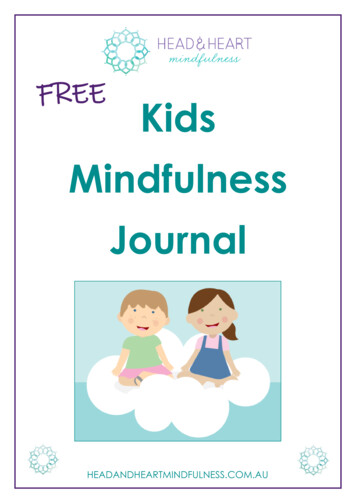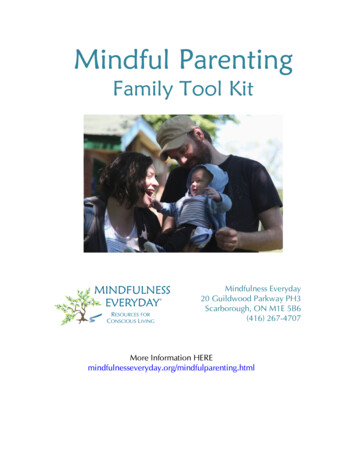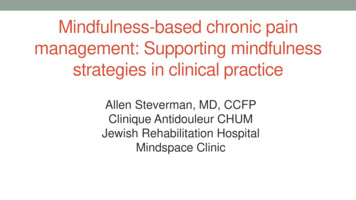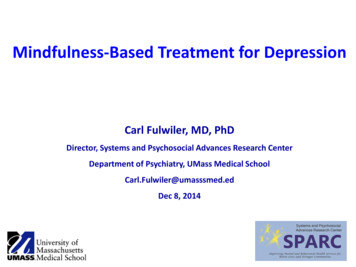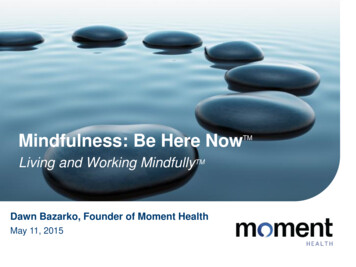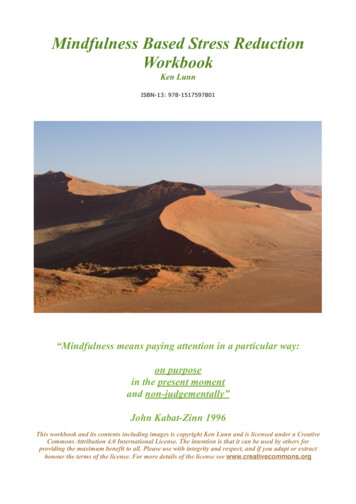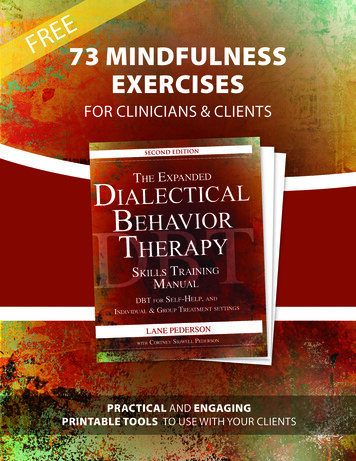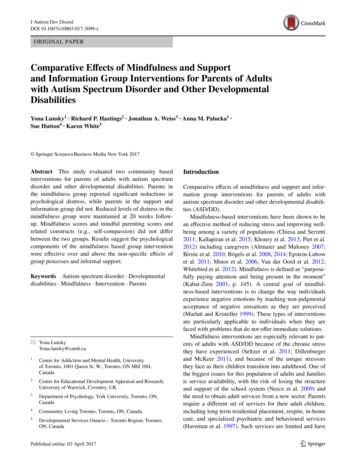
Transcription
J Autism Dev DisordDOI 10.1007/s10803-017-3099-zORIGINAL PAPERComparative Effects of Mindfulness and Supportand Information Group Interventions for Parents of Adultswith Autism Spectrum Disorder and Other DevelopmentalDisabilitiesYona Lunsky1 · Richard P. Hastings2 · Jonathan A. Weiss3 · Anna M. Palucka1 ·Sue Hutton4 · Karen White5 Springer Science Business Media New York 2017Abstract This study evaluated two community basedinterventions for parents of adults with autism spectrumdisorder and other developmental disabilities. Parents inthe mindfulness group reported significant reductions inpsychological distress, while parents in the support andinformation group did not. Reduced levels of distress in themindfulness group were maintained at 20 weeks followup. Mindfulness scores and mindful parenting scores andrelated constructs (e.g., self-compassion) did not differbetween the two groups. Results suggest the psychologicalcomponents of the mindfulness based group interventionwere effective over and above the non-specific effects ofgroup processes and informal support.Keywords Autism spectrum disorder · Developmentaldisabilities · Mindfulness · Intervention · Parents* Yona LunskyYona.lunsky@camh.ca1Centre for Addiction and Mental Health, Universityof Toronto, 1001 Queen St. W., Toronto, ON M6J 1H4,Canada2Centre for Educational Development Appraisal and Research,University of Warwick, Coventry, UK3Department of Psychology, York University, Toronto, ON,Canada4Community Living Toronto, Toronto, ON, Canada5Developmental Services Ontario – Toronto Region, Toronto,ON, CanadaIntroductionComparative effects of mindfulness and support and information group interventions for parents of adults withautism spectrum disorder and other developmental disabilities (ASD/DD).Mindfulness-based interventions have been shown to bean effective method of reducing stress and improving wellbeing among a variety of populations (Chiesa and Serretti2011; Kallapiran et al. 2015; Khoury et al. 2013; Piet et al.2012) including caregivers (Altmaier and Maloney 2007;Birnie et al. 2010; Bögels et al. 2008, 2014; Epstein-Lubowet al. 2011; Minor et al. 2006; Van der Oord et al. 2012;Whitebird et al. 2012). Mindfulness is defined as “purposefully paying attention and being present in the moment”(Kabat-Zinn 2003, p. 145). A central goal of mindfulness-based interventions is to change the way individualsexperience negative emotions by teaching non-judgmentalacceptance of negative sensations as they are perceived(Marlatt and Kristeller 1999). These types of interventionsare particularly applicable to individuals when they arefaced with problems that do not offer immediate solutions.Mindfulness interventions are especially relevant to parents of adults with ASD/DD because of the chronic stressthey have experienced (Seltzer et al. 2011; Dillenburgerand McKeer 2011), and because of the unique stressorsthey face as their children transition into adulthood. One ofthe biggest issues for this population of adults and familiesis service availability, with the risk of losing the structureand support of the school system (Neece et al. 2009) andthe need to obtain adult services from a new sector. Parentsrequire a different set of services for their adult children,including long term residential placement, respite, in-homecare, and specialized psychiatric and behavioural services(Haveman et al. 1997). Such services are limited and have13Vol.:(0123456789)
J Autism Dev Disordlong waiting lists (Lakin 1998). As a result, parents oftenremain responsible for supporting their child with ASD/DDwell into adulthood (Braddock et al. 2001). At the sametime, these older parents themselves are increasingly facingtheir own health issues due to aging, which makes it evenmore difficult to provide care (Hatzidimitriadou and Milne2005).Most of what we know about mindfulness as it relates tomulti-stressed families of children with disabilities comesfrom research based on families with younger children.Increased general mindfulness and mindfulness in the parenting role, as well as increased psychological acceptancein general and in the parenting role, have been associatedwith reduced psychological distress for mothers and fathersof children with ASD/DD (Jones et al. 2014; Lloyd andHastings 2008; MacDonald et al. 2010; Weiss et al. 2012).More than a dozen studies evaluating mindfulness-basedinterventions for parents of individuals with ASD/DD havebeen published since 2005. Singh et al. (2006, 2007), usinga single case experimental design methodology, showedthat mindfulness meditation increased parents’ feelingsof competence and satisfaction, and decreased aggressivebehaviours in their children. Subsequent research has confirmed these early findings (Cachia et al. 2016) with severalstudies demonstrating that decreases in parental stress anddepression could be maintained several months later (e.g.,Bazzano et al. 2015; Ferraioli and Harris 2013). In additionto studying clinical outcomes of parents and sometimeschildren, several studies have also measured the effects ofmindfulness training on mindfulness based measures suchas mindfulness, self-compassion, and mindful parenting,with mixed results (e.g., Bazzano et al. 2015; Ferraioli andHarris 2013; Jones et al. 2016; Lunsky et al. 2015).We could find only two studies of mindfulness-basedinterventions for parents that included an active controlcomparison design. Such designs can test whether the putative benefits observed for an intervention are specific tothe intervention or simply to any support offered to families. Ferraioli and Harris (2013) compared a mindfulnessbased parent training group provided to 10 parents of children with an ASD to a skills-based parent training groupprovided to 11 parents. Parents were randomly assignedto one of the two 8-session interventions, with the skillsbased parent group serving as an active treatment control.The mindfulness group demonstrated significant reductionsin stress and improvements in overall self-reported healthrelative to the control condition, which showed no significant improvements. Like the majority of descriptive studiesand those incorporating a waitlist control group (Benn et al.2012; Neece 2014), Ferraoli and Harris (2013) focusedon parents of young children. The second active treatmentcontrolled study by Dykens et al. (2014) had the largestsample to date (243 mothers of children with ASD/DD),13and compared parent outcomes of a modified MindfulnessBased Stress Reduction (MBSR) program to a “positiveadult development” intervention, each six sessions in lengthand facilitated by mothers who were themselves trained ineach intervention. Mothers who attended the mindfulnessgroup showed greater reductions in depression and greaterimprovements in life satisfaction and sleep compared tothe positive adult development group, which also showedsignificant improvements over the course of treatment.The Dykens et al. study included some older parents, butfocused primarily on parents of children and youth, with amean parent age of approximately 41 years.The majority of parent mindfulness studies have focusedon parents of children and youth with ASD/DD, with onlya few studies including any parents of adults in their interventions. Given the importance of psychological supportsfor parents of adults with ASD/DD, and the reality thatmost of these families experience significant service gaps,members of our team sought to develop an intervention tomeet the unique needs of these parents. In consultation withone of its authors (Segal), we adapted mindfulness-basedcognitive therapy (MBCT: Segal et al. 2002) for parentsand adolescents and adults with ASD/DD. Our consultationled to the development of a 4 weeks pilot, which we thenrefined into a six week group, with three intervention foci(for further detail on the development and evaluation of ourintervention, read Lunsky et al. 2015):1. These parents have been exposed to chronic stress,some of which cannot be easily resolved. Mindfulnesscan teach parents to experience difficult situations in adifferent way, which is less solution focused.2. Self-care is essential for parents who because of ongoing caregiving requirements can become emotionallyand sometimes physically depleted. Mindfulness canteach these parents to become more aware of theirphysical and emotional needs, to prevent parentalexhaustion.3. There is also stress associated with daily interactions with adult children with ASD/DD, particularlywhen services are not in place. Parent and child stresscombined can lead to reactive interactions which canincrease stress. Mindfulness can lead to more mindfulparent child interactions, which can reduce this stress.Our intervention diverged from more standard MBCTand MBSR in a few ways: Given the limited time of parents to practice exercises, we adopted the briefer audiohomework recordings from Finding Peace in a FranticWorld (Williams and Penman 2012) knowing that families, particularly those with children who were not in anyday time programs, might have difficulty finding protected time to complete these practices (see also Jones
J Autism Dev Disordet al. 2016). We provided paper based homework andCD recordings in addition to web based links becausenot all parents were comfortable with the internet. Weemphasized the 3 min breathing space from MBCT overother practices, and practiced it regularly during groupsessions because we considered it to be the most portable exercise for these parents. We also explored howto weave practices into current life circumstances, asopposed to promoting changing schedules to accommodate more intensive practice which, parents had taughtus, was not realistic. In contrast to standard MBSR orMBCT, we did not hold a full day retreat, because werecognized the challenge of scheduling this for familiesand did not want to limit the number of parents willingto participate in the intervention. In terms of specific insession practice modifications, we completed the bodyscan in chairs because it was difficult for several parentsto get up and down from the floor. Therapist voices wereloud enough to accommodate hearing loss associatedwith older age.We included the loving-kindness meditation fromMBSR because we thought this concept was particularly relevant to parents of children with disabilities, andwe also introduced parents to the idea of performing amindful activity with their child as part of homework,which they could reflect upon in session. We allowed forextended time within each session, during a 15 to 20 mintea break, for parents to reflect more generally abouttheir situation, and connect with one another and we promoted the importance of self care activities throughout.In our evaluation of this new intervention (Lunsky et al.2015), we found that parents of older adolescents andadults reported reductions in stress and general groupsatisfaction but we did not observe significant improvements in mindfulness ratings. Our initial study, althoughpromising, failed to include any sort of control group, orfollow-up component. We could therefore not determinehow many of the benefits from this effort were due tothe fact that parents, many of them quite isolated, weremeeting regularly with other parents for the first time, ina nurturing warm environment, to explore ways to bettercare for themselves and their children.The purpose of the present study was to compareclinical outcomes for parents of adults with ASD/DDassigned to one of two parent focused interventionsoffered while waiting for social services for their children. Our primary research question was whether themindfulness-based intervention led to lower levels ofparent distress compared to the active control intervention (parent support and education). Secondary outcomes included mindfulness, mindful parenting, selfcompassion, empowerment, perceptions of positive gain,and caregiver burden.MethodsDesignThis study included two arms: mindfulness, and supportand information. Assignment was done sequentially usinga pseudo-randomization approach, A—mindfulness, B—support and information, in the order that parents arrivedto orientation, after they had completed baseline measures.This was done to ensure that intervention groups of similarsize would be filled as soon as possible—due to the tighttimelines for the research. Six couples asked to be involvedin the study. When parents came as a couple, the couplewas assigned as a pair as though they were a single person. At the point of analysis, if both members of the couple had completed questionnaires, one member of the couple was selected randomly for analysis. Parents completedbaseline measures after consenting to the study, prior togroup assignment. As indicated in the CONSORT diagram(Fig. 1), not all parents who completed consent forms andquestionnaires came to the first group intervention session.Baseline measures were completed online or on paperprior to group assignment. Parents in both interventiongroups completed the same measures at week 8, and for athird time at week 20, approximately 3 months after interventions were completed. Figure 1 shows that 138 parentsof adolescents or adults with ASD/DD expressed an initialinterest in participating in the study. Of these parents, 69were excluded for a variety of reasons, resulting in 57 whoconsented and enrolled in the study. Data were excludedfrom analysis for four parents who were part of couplesin the mindfulness group and two parents who were partof couples in the parent support and information group.An additional person was excluded from analysis becauseof limited English not recognized during initial telephonescreening, leaving 50 cases.ParticipantsDemographics of the 50 parents in the two groups and theirchildren are presented in Table 1. Groups did not differ atbaseline with respect to parent age, or in terms of the percentage of mothers (versus fathers), English as a secondlanguage, or marital status (all p .15). There were also nobaseline differences in child demographics, or percentageof children with a diagnosis of ASD, a genetic syndromeor a psychiatric diagnosis, or in the kinds of activities theyprimarily engaged in during a typical week (all p .15).RecruitmentParents were recruited through Developmental ServicesOntario (DSO), Toronto office. The DSO office is the13
J Autism Dev DisordFig. 1 CONSORT-style diagram for the trialAssessed for eligibility (N 138)Excluded (n 69)24 ming did not work12 did not meet criteria (language, age)7 not interested4 transporta on/health2 child care20 other/lostRandomized (N 57)MindfulnessParent Informa on & SupportAllocated to interven on (N 30)Allocated to interven on (N 27)- Included in data (N 26)- Included in data (N 24)- Excluded from data (N 4)- Excluded from data (N 3)4 part of a couple (spouse included)1 did not speak sufficient English2 part of a couple (spouse included)Number of ques onnaires completed at eachme point- Time 1 26 (100%)Time 2 26 (100%)Time 3 20 (76.9%) (6 others did not completeques onnaires)“front door” for services for all adults with ASD/DD in theregion and provides a standardized approach to applyingfor and obtaining services, across the province. Eligibilityrequirements for this study were that parents had to havea child with ASD/DD age 16 and above, had to be waitingfor adult services in the Toronto region through the TorontoDSO, and had to have sufficient English to complete written surveys and participate in groups. The age of 16 wasselected because that is the age at which parents can applyfor adult services through the DSO for their son or daughter in Ontario. This study received ethics approval fromrelevant university and hospital ethics boards, and was registered with Clinical Trials (http://www.clinicaltrials.gov).All parents registered with the Toronto DSO officewho were waiting for services were sent a letter in themail, followed by an email when email addresses were13Number of ques onnaires completed at eachme pointTime 1: 24 (100%)Time 2: 20 (83.3%) (4 did not completeques onnaires, 3 of whom dropped out)Time 3: 17 (70.8%) (7 others did not completeques onnaires)available, describing the parent intervention project. Thisletter explained that the groups for parents would be free,that parents would be compensated for participating inthe research, and that free childcare would be providedfor their son/daughter during the times of the group session. Interested parents could either complete a formexpressing their interest in learning more about the studyand mail, email or fax it to the research team, or theycould call the research team directly. The research staffscreened each parent at this stage, explained the studyin greater detail and sent the parent an information letterand consent form. Parents who consented to participatein the study and who met study criteria were then invitedto attend the initial orientation, where they completed theconsent process, questionnaires and assignment to condition, and orientation.
J Autism Dev DisordTable 1 Participant demographicsMindfulness(N 26)Support andinformation(N 24)Total(N 50)Parent demographicsAge, mean (SD)56.3 (8.2)56.9 (8.7)56.6 (8.3)Age min–max37–7744–8137–81Gender (% female)19 (73.1)16 (66.7)35 (70.0)Second language (%)8 (30.8)12 (50.0)20 (40.0)Married (%)15 (57.7)11 (73.3)26 (63.4)Child demographicsAge, mean (SD)22.7 (5.4)22.7 (6.0)22.7 (5.7)Age min–max16–4017–3816–40Gender (% female)13 (52.0)11 (45.8)23 (46.0)Child disability (based on open ended question about child’s diagnosis)ASD (%)9 (34.0)13 (54.2)22 (44.0)Genetic syndrome (%)4 (15.4)3 (12.5)7 (14.0)Psychiatric disorder (%) 4 (15.4)1 (4.2)5 (10.0)Child day activity (based on open ended question about what doesyour child do each day?)School (%)11 (47.8)12 (66.7)23 (56.1)Home (%)6 (26.1)4 (22.2)10 (24.4)Work/day program (%)6 (26.1)2 (11.1)8 (19.5)InterventionsThe two interventions were developed to be as similar aspossible in terms of group structure. They were offered fourtimes between October 2013 and April 2015. Each groupincluded an orientation session followed by six 2-h weeklysessions. The interventions were held simultaneously in thesame building with a shared care service available, and parents not using the care service could request a stipend tosupport off site care costs ( 50.00 CAN). Both groups wereco-facilitated by clinicians experienced in either facilitating mindfulness-based interventions, or facilitating supportgroups and providing parents with information on adultservices. Parents in both groups received an orientationpackage outlining what would be covered within the sessions, and relevant handouts weekly. When the study wascompleted, parents received a package with informationand resources that were distributed to the other group.The mindfulness-based intervention was co-facilitatedby two clinicians with group mindfulness facilitation experience. The first clinician was a psychologist with over15 years of experience in a specialized mental health service within a university affiliated hospital for adolescentsand adults with ASD/DD, and was one of the developersof the treatment manual used in the study. She was trainedto facilitate mindfulness based group practices in 2009at a teaching hospital in Toronto and continues to attendrelated workshops and retreats. The second clinician, asocial worker in the ASD/DD field, had been trained andsupervised by expert teachers at the Centre for Mindfulnessin Massachusetts, where courses have been delivered for30 years, and had over 10 years of experience facilitatinggroup based mindfulness based stress reduction for different populations.Session content focused on experiential learning of meditation techniques (e.g., sitting meditation, walking meditation, gentle yoga), drawing from MBCT (Segal et al. 2002)and MBSR (Kabat-Zinn 1990) programs. Practice withinsessions ranged from 3 (3-min breathing space) to 20 min,which are briefer than formal mindfulness practices completed in traditional MBSR and MBCT. Each session beganwith a check-in and review of homework, followed by someexperiential exercises and reflections, with a 15 to 20 mintea break mid-session.The parent support and education intervention was cofacilitated by two clinicians who worked for DSO Toronto,assisting parents to find services, and helping them tounderstand how adult services in Toronto are organized.Together with other members of the research team, theseclinicians developed the support and education intervention. Each week, there was an initial check-in, similar tothe mindfulness based group, followed by a guest presentation on a topic selected by group members, followed bysome facilitated discussion about the weekly topic, in addition to some more general discussion. Like the mindfulnessbased intervention, each week also included a 15–20 mintea break for parents to interact more informally with oneanother. Topics included: getting to know adult developmental services and how to access resources; persondirected planning; caregiver issues and respite (“taking careof us”); specialized clinical services; crisis supports; andresidential alternatives.MeasuresPrimary outcome measure A 14-item version of theDepression Anxiety Stress Scale (DASS-21; Henry andCrawford 2005) was used to assess perceived psychological distress (the seven stress and seven depression items) ateach time point, focused on the previous week. This measure was adopted in our prior pilot study of the mindfulnessbased intervention (Lunsky et al. 2015) and has been usedin other mindfulness and acceptance based parent intervention studies (e.g., Jones et al. 2016; Rayan and Ahmad2016; Whittingham et al. 2016). Participants respondedusing a 4-point Likert scale ranging from 0 “did not applyto me at all” to 3 “applied to me very much, or most of thetime”, yielding a total score between 0 and 42. An overallpsychological distress score was calculated by taking thesum of the 14 items. The combined 14 item psychological13
J Autism Dev Disorddistress scale had a Cronbach’s alpha of 0.94 for the 14items at baseline across the total parent sample.Secondary outcome measures We selected 4 secondary outcome measures focused on aspects of mindfulnessand relationship with child, which we hypothesized couldalso reflect psychological dimensions that may be affectedby the mindfulness intervention and subsequently relate toreduced psychological distress. We also included one secondary outcome measure focused on parent empowerment,which we hypothesized may be increased in the supportand information group. We also included a caregiver burden questionnaire to evaluate whether either interventionmight influence burden perceptions.The Five Facet Mindfulness Questionnaire (FFMQ;Baer et al. 2006) and the Bangor Mindful Parenting Scale(BMPS; Jones et al. 2014) were adopted to assess mindfulness and mindful parenting respectively. The FFMQis a 39-item self-report questionnaire that consists of fivesubscales that measure five component skills of mindfulness (observing, describing, act awareness, non-judging ofinner experiences, and non-reactivity to inner experiences).The measure utilizes a 6 point Likert scale ranging from 0“almost never” to 5 “almost always”, with a higher overall score reflecting greater levels of overall mindfulness.The FFMQ total score had Cronbach’s alpha of 0.89 in thisstudy. The BMPS is a 15-item self-report questionnaire thatmeasures how mindful parents are in their parenting roleand in interactions with their children. Each item is ratedon a 4-point Likert scale ranging from 0 “never true” to 3“always true”, yielding a total score ranging from zero to amaximum of 45. Cronbach’s alpha for the scale was 0.83,similar to previous reports (Jones et al. 2014). Related tothe broader construct of mindful parenting, the PositiveGain Scale (PGS; Pit-ten Cate 2003) is 7-item measurethat assesses caregivers’ perceptions of positive contributions their child with disability has made to their lives.The measure utilizes a 5-point Likert scale, ranging from 1being “strongly agree” to 5 being “strongly disagree.” Thepositive gain scale has demonstrated good internal consistency with a reported Cronbach’s alpha of 0.84 in the current study.The Self-Compassion Scale Short-form (SCS-SF; Neff2003) is a 12-item self-report scale with higher scores indicating greater levels of self-compassion, a construct highlycorrelated with general mindfulness, and one which mindfulness based interventions may impact. Responses arescores on a 5-point scale ranging from 1 “almost never” to5 “almost always”. The scale demonstrated good internalconsistency with a Cronbach’s alpha of 0.83.To assess feelings of empowerment, a construct wehypothesized might be targeted in any parent education orskills intervention, two 12-item subscales (Family and Service System) from the 34-item Family Empowerment Scale13(FES; Koren et al. 1992) were administered. Responses aregiven on a 5-point Likert scale ranging from 1 “never” to 5“very often”, with a reported Cronbach’s alpha of 0.83 and0.86 respectively in the present study.Caregiver burden, which we hypothesized could beinfluenced by either the provision of further information and support, or by developing mindfulness skills wasassessed using the Caregiving Burden 9-item subscale ofthe Revised Caregiving Appraisal Scales (Lawton et al.2000). Items measure caregiver’s perception of the negativeimpact caregiving has had on his or her health, well-being,social life and personal relationships. Responses are scoredusing a 5-point Likert scale, ranging from 5 “agree a lot” to1 “disagree a lot”. Higher scores reflect greater perceivedburden. The scale had a good internal consistency of 0.85in the current study.In addition, parents completed a 10-item measure onintervention group satisfaction (e.g., content relevancy,usefulness, interest level, and feeling valued in the group)on a 5-point Likert scale from 1 “strongly disagree” to 5“strongly agree”. The measure demonstrated good internalconsistency (Cronbach’s alpha 0.87).ResultsPrimary OutcomeTo address our research questions, our analyses focused ongroup differences at post-intervention (potential effectiveness) and then on the putative maintenance of any intervention group differences over time to 20 weeks followup. Analysis of covariance was used to determine whethergroups differed in their psychological distress (compositedepression/stress-DASS 14) scores post intervention (Time2) after controlling for pre-intervention levels (Time 1). Asshown in Table 2, results indicated a significant main effectof group assignment on parent psychological distress F(1,43) 11.73, p .001, Cohen’s d 0.81 at Time 2, in favorof the mindfulness condition. In an exploratory analysis,we considered whether having a different number of children with ASD in the two arms of the trial had any impacton the results. We repeated the main analysis and added anadditional covariate (whether the child had an ASD diagnosis). The pattern of results was the same.To examine the maintenance of the intervention effecton the primary outcome to the 20 weeks follow-up, we carried out an ANCOVA with time (Time 2, Time 3) as therepeated measures factor, Time 1 DASS-14 score as covariate, and intervention group as the between subject variable. This analysis revealed a significant group effect [F(1,38) 10.24, p .003], but no effect of time [F(1, 38) 2.58,p .12], nor a group time interaction [F(1, 38) 0.39,
J Autism Dev DisordTable 2 Scores for outcome measures at baseline and post-intervention for both study groupsMindfulnessDASS 14FES: servicesFES: familyFFMQBMPSBurdenSelf-compassion scalePositive Gain ScaleParent supportANCOVATime 1Time 2Time 1Time 2FCohen’s dP value16.65 (11.76)(N 26)46.77 (6.50)(N 26)42.87 (6.99)(N 26)127.95 (17.54)(N 25)30.52 (6.76)(N 26)26.58 (9.17)(N 26)37.96 (9.62)(N 25)12.64 (4.74)(N 26)11.21 (7.07)(N 26)47.73 (7.58)(N 26)45.26 (7.15)(N 26)132.93 (13.22)(N 25)31.35 (5.94)(N 26)25.69 (8.35)(N 26)39.20 (8.71)(N 25)13.88 (6.18)(N 26)14.15 (8.73)(N 20)42.45 (7.68)(N 20)39.25 (4.89)(N 20)126.69 (17.80)(N 17)28.70 (6.86)(N 20)24.93 (7.99)(N 18)38.10 (7.28)(N 20)14.56 (3.64)(N 20)15.15 (6.59)(N 20)45.69 (7.81)(N 20)41.61 (7.72)(N 20)127.79 (18.23)(N 17)29.20 (6.25)(N 20)26.11 (8.34)(N 18)38.40 (6.47)(N 20)13.40 (4.27)(N 20)11.730.810.0010.520.350.480.470.090.501.47 0.260.230.59 0.090.440.450.240.500.36 0.130.551.64 0.540.21Note FES family empowerment scale, FFMQ five factor mindfulness questionnaire, BMPS Bangor mindful parenting scalep .84]. These results suggest that the intervention groupdifference at post-intervention was maintained until the 20weeks follow-up point.Secondary OutcomesWith regard to mindfulness outcomes, ANCOVA revealedno significant main effect of group assignment on theFFMQ total score or BPMS scores at Time 2 after controlling for Time 1 scores (as shown in Table 2). Similarly,there was no main effect of group assignment on the otherparent measures (empowerment, burden, self-compassion and positive gain) scales after controlling for Time 1scores. Effect sizes for each of the secondary outcomes atTime 2 are displayed in Table 2. As for the primary outcome, we also repeated all analyses of the secondary outcomes including ASD as an additional covariate. Again, thesame pattern of findings was obtained.Attendance and Satisfaction with Intervention SessionsSession participation varied amongst the sample of 50 parents included in the study. Forty-two parents attended themajority of the sessions (at least 4 out of the 6 sessions).Participants attended a mean of 4.88 sessions (SD 1.31)in the mindfulness group, and 4.29 (SD 1.49) sessions inthe parent support and information group. The most commonly cited barriers to regular attendance
mindfulness training on mindfulness based measures such as mindfulness, self-compassion, and mindful parenting, with mixed results (e.g., Bazzano et al. 2015; Ferraioli and Harris 2013; Jones et al. 2016; Lunsky et al. 2015). We could find only two studies of mindfulness-based interventions for parents that included an active control
